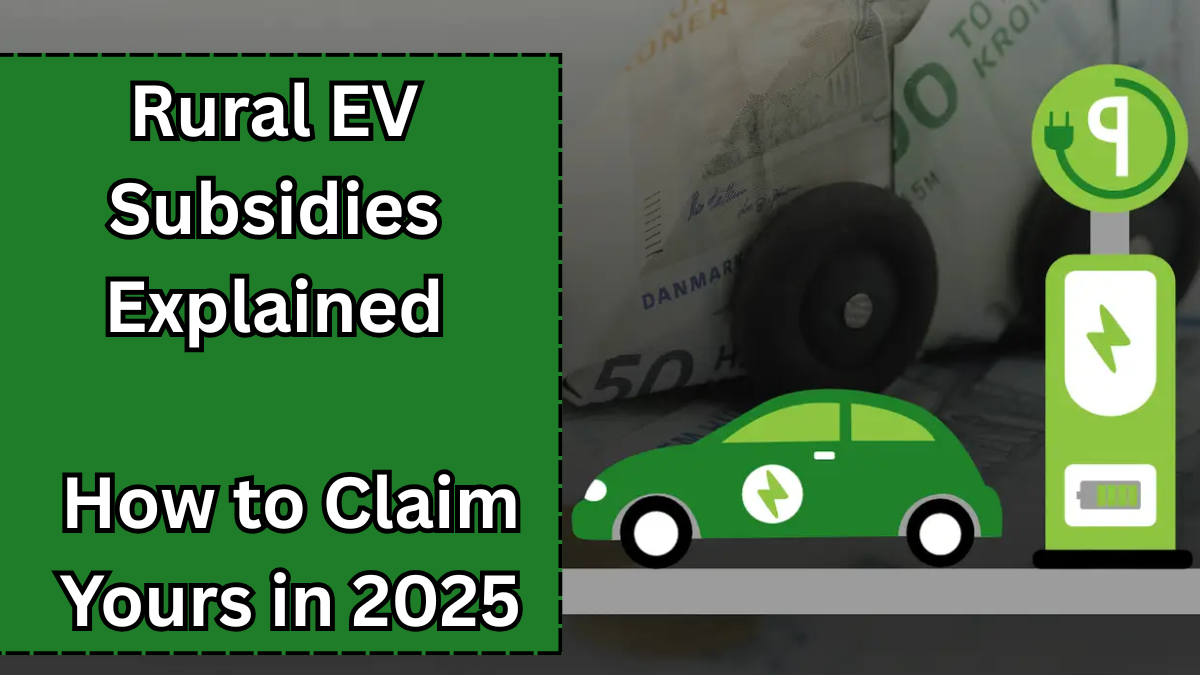As India accelerates toward sustainable transportation, 2025 is shaping up to be a milestone year for rural India. With a strong push toward electric mobility, EV subsidies in India are being revamped to include and uplift rural consumers. This initiative isn’t just about green travel—it’s about empowerment, access, and inclusion.
Let’s break down what rural consumers need to know to take full advantage of these subsidies.

Why Rural EV Subsidies Matter?
Electric vehicles (EVs) are no longer just for city dwellers. In fact, rural India is now a critical focus for both state and central governments.
Here’s why:
-
Rural areas often lack robust public transport—EVs fill this gap
-
EV adoption reduces fuel dependency in remote regions
-
These subsidies can ease the financial burden on rural families
-
Promotes local job creation in EV servicing and manufacturing
What’s New in EV Subsidies for Rural India in 2025
2025 brings a fresh update to the EV subsidies in India, especially designed to support rural consumer benefits.
| Feature | Details |
|---|---|
| Subsidy Coverage | Up to ₹30,000 on electric 2-wheelers and 3-wheelers |
| Additional Rural Incentive | Extra ₹10,000 for residents of villages and Tier-3 towns |
| Charging Infrastructure | Government to fund 50% of cost for installing rural chargers |
| Eligibility Expansion | Farmers, SHG women, and rural youth are now eligible |
| Loan Interest Subsidy | 2-3% interest subvention on loans for EV purchase |
Who Can Apply for These Subsidies?
The 2025 EV policy is inclusive. If you tick any of the boxes below, you’re good to go:
-
Reside in a rural or semi-rural area
-
Belong to a farmer household or Self-Help Group (SHG)
-
First-time vehicle owner
-
Member of Scheduled Caste/Scheduled Tribe
-
Women-led households and micro-entrepreneurs
Steps to Claim Your Rural EV Subsidy
Claiming your subsidy doesn’t need to be complicated. Here’s a simple roadmap:
-
Choose an Approved EV
Select a model that qualifies under the FAME or state EV policy list. -
Register via EV Portal
Visit the official state EV subsidy portal and fill in your personal and vehicle details. -
Submit Rural Residence Proof
Upload documents such as Aadhaar, voter ID, and ration card indicating your rural address. -
Get Dealer Verification
The EV dealer will validate your documents and initiate subsidy filing. -
Receive Direct Transfer
Subsidy is credited directly to your bank account or adjusted in invoice.
Rural Charging Network – A Boost for Accessibility
To support these rural consumer benefits, a rural charging ecosystem is also being developed.
| Charging Support | Initiatives |
|---|---|
| Panchayat-level Stations | 5,000 new charging points in villages by 2025 |
| Mobile Chargers | EV charging vans to cover remote areas |
| Community EV Points | Shared charging hubs for 3-5 villages |
| Power Subsidy | 50% electricity subsidy for rural EV users |
Local Skill Development for Rural EV Jobs
Another hidden gem of this initiative is job creation. The government is tying up with ITIs and rural training centres to upskill youth in:
-
EV maintenance
-
Battery repair
-
Charging station management
-
Basic electricals for EV systems
These trainings are often free or heavily subsidized—ensuring inclusive growth.
FAQs
1. Can I apply for an EV subsidy if I already own a petrol bike?
Yes, but priority is given to first-time EV buyers in rural areas. Existing vehicle owners can still apply but may get lower-tier benefits.
2. Are electric tractors eligible for subsidy?
Not under the standard FAME II scheme, but some state-specific schemes do include agricultural EVs. Always check local guidelines.
3. Is the subsidy deducted from the EV price or credited later?
Both options are available. Some dealers offer upfront discounts; others process it for later bank transfer.
4. How can women in SHGs benefit from EV subsidies in India?
SHG women can access enhanced subsidies, especially for e-rickshaws and cargo EVs, helping boost their local entrepreneurship.
Final Thoughts
India’s rural heartland is stepping into the electric future—and not just by adopting new vehicles, but by embracing an entire ecosystem of change. These EV subsidies in India are about more than money—they’re about giving rural consumer benefits the attention they deserve.
If you live in a village or small town, now’s the time to go electric, save big, and drive change.
Click here to learn more
Pari is a passionate writer known for captivating stories that blend imagination and reality. Inspired by travel, history, and everyday moments, Pari crafts narratives that resonate deeply with readers.